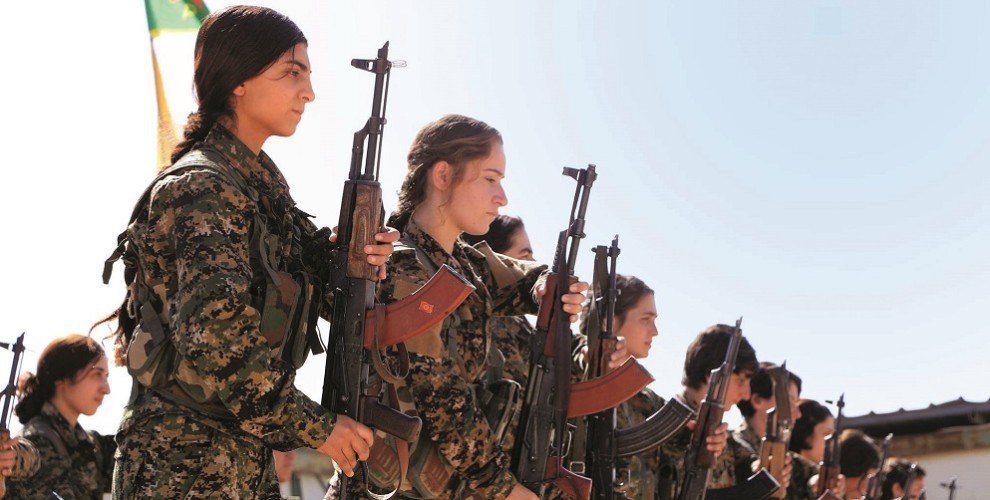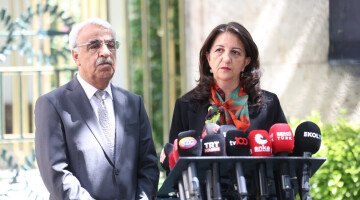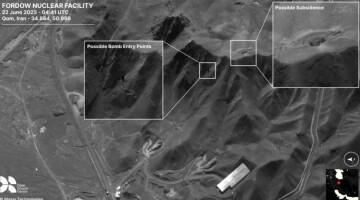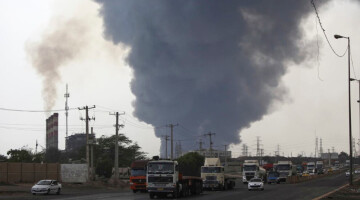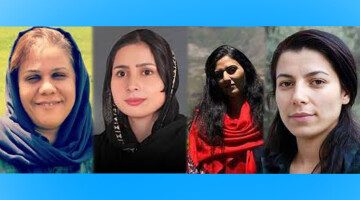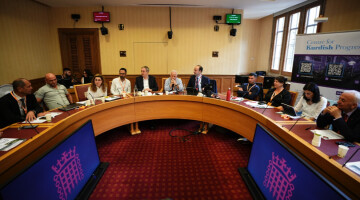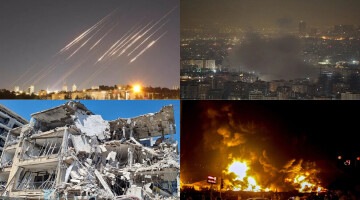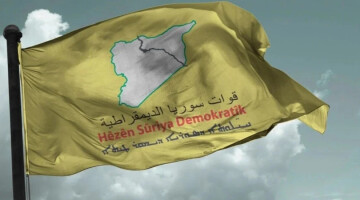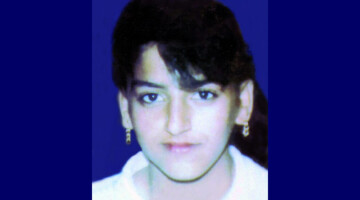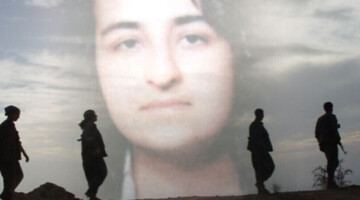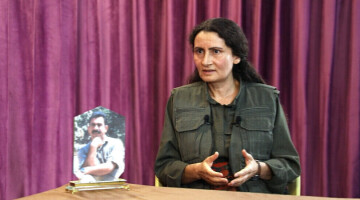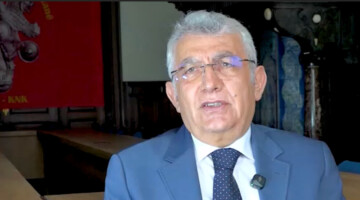How did the US end up supporting the Kurds in Rojava?
Since October 2014 the Syrian Kurds and their non-Kurdish Allies have discussed military cooperation with the US-led Global Coalition against the “Islamic State” (IS). Towards the end of 2014, the mainly Kurdish People’s/Women’s Defense Units (YPG/YPJ) defended Kobanî, nowadays the Syrian Democratic Forces (SDF), which includes ten thousand non-Kurds in its ranks, have liberated Raqqa, the de facto IS capital and the eastern parts of the Deir Ez-Zor province. Many leftist and progressive organizations and movements around the world have discussed and were divided about this military cooperation due to the historically contradictory ideological positions of the two forces. On the one hand there are those including some within the Kurdish solidarity organisations, who voiced concerns that the revolution of Rojava could lose its emancipative-liberating value and independent stance. On the other hand, critics think that the SDF is already instrumentalized by the US and has betrayed the revolution.
The critic forgets often that since its liberation in 2012 Rojava (Syrian Kurdistan) has also direct relations with Russia, the other global power in Syria. Actually since the start of the Syrian civil war the Kurds try to balance their relations with all international and the most regional power in order to have space to develop their political model.
Before the great war of Kobanî
The revolutionary movement in Rojava, represented mainly by the Party of Democratic Union (PYD), is in the broader sense part of the “Kurdish Freedom Movement” (KFM). The KFM includes several leftist Kurdish origin political and social movements of which the Kurdistan Workers Party (PKK) is the most known, as well as the strongest and most crucial. When the armed struggle was started by the PKK in North Kurdistan (Bakur) against the occupying Turkish state in 1984, all NATO states, particularly Germany and US, actively supported the Turkish state militarily, politically and economically. Turkey resorted to broad state terror in the 90s when the PKK became a mass movement. Tens of thousands of Kurds were murdered, hundreds of thousands tortured, and three million Kurds were displaced due to the destruction of 4000 villages, in addition all legal activities for Kurds were de facto banned. Until then the states in the world and in region did not foresee any collective rights for the Kurds whose lands have been split in four states as an international colony.
In parallel, the US started supporting the two main Kurdish groups in the South (Iraq) Kurdistan which were ideologically and politically easily influenced and controlled; the conservative Democratic Party of Kurdistan of Iraq (PDK/KDP) under M. Barzani and the Patriotic Union of Kurdistan (YNK/PUK) under C. Talabani. After the Gulf War of 1991 a no-fly zone was created in order to give them some space. With the US occupation of Iraq in 2003, South Kurdistan got the official status of an autonomous region. While the PDK and PUK were welcomed, other Kurdish organizations have been considered mostly undesirable or even terrorist. The PKK was one of most prominent among the latter groups and has been even listed by Germany, the US and the EU as a “terrorist organization”. This ban has led to the criminalization of many Kurds, particularly by Germany. In 1999 it was the CIA which coordinated the international plot against Abdullah Öcalan, the leader of the PKK, and handed him over to Turkey.
The YPG/YPJ are the defense forces of Rojava where the Movement for a Democratic Society (TEV-DEM) has started a revolutionary process in 2011. TEV-DEM has been initiated by the PYD and consists mainly of direct democratic structures and several organizations and parties. Far from the interest of the global public, which expected mainly the fall of the Ba’ath regime, TEV-DEM organized in a strong way the Kurdish society, and became the biggest political force in Rojava within a short time and together with the YPG liberated territories of Rojava starting in Kobanî on July 19, 2012.
The “Revolution of Rojava”, which did not participate strongly with any armed forces until the end of 2012, refers to this date nowadays. The right wing party block ENKS (Kurdish National Council in Syria) in Rojava, with close ties to the PDK of Barzani, had no role in this liberation process and lost more and more support from the Kurdish population. With communes, people’s councils, academies and cooperatives TEV-DEM spread revolutionary thoughts and practices in the society based on the concept of “Democratic Confederalism”. This has been developed by the imprisoned Öcalan who had lived 19 years in Syria. It is based on the paradigm of a democratic, communal, ecological and gender liberated society. This social revolution of the poorest and most discriminated people within the Syrian state has been led mainly by women at a very early stage.
At that time the biggest solidarity came from Bakur from where the embargo, imposed by the Turkish state after the liberation of Rojava, could be perforated. In Syria and more generally the Middle East almost no political force took the young revolution seriously. Internationally only a few political organizations were in strong solidarity; these were groups already working on Kurdistan. There were almost no international fighters, only some Turkish revolutionaries joined the YPG and YPJ until summer 2014. However, with mainly local Arabs and Syriacs, there were already more than 1000 non-Kurdish fighters within the YPG/YPJ.
This participation of non-Kurds highlights another crucial character of this revolution which is the emphasis on the sisterhood of all cultures and a rejection of the nation-state. This was a significant aspect when in January 2014 the Democratic Self Administration (DSA) has been founded with the broader inclusion of Arabs, Syriacs and further Kurdish parties in three main regions (cantons) of Rojava. The development of a third and democratic way for the solution of the bloody conflict in Syria became one main goal of the DSA. However, on a Syrian and international level the DSA has not experienced a serious recognition as an opposition force and was not invited to join the Geneva peace talks on Syria. The regional and international political powers were still not interested to give any space to this new political project.
Shortly after the liberation of most parts of Rojava the Turkish state pressured reactionary-chauvinist-jihadist organizations in Syria to militarily attack Rojava. The attacks started in November 2012 in Serêkaniye and continued in the summer of 2013 when IS (at that time named ISIS/ISIL), Al-Nusra and some units of the FSA started a big campaign against Cizîre and Afrîn. All have been defeated successfully. There was not any critic or action by any regional or international government against these attacks. Rojava was not part of their future plans for Syria.
It should be underlined that the revolution and all its achievements in Rojava have been realized completely with its own force, population and policies as well as with the support of Kurds from Bakur and a limited number of internationalists. The claim that the Syrian regime handed over Rojava to TEV-DEM and YPG/YPJ is not true. The moment of liberation started when there was a moment of major destabilization of the Syrian regime in the summer of 2012. TEV-DEM and YPG benefited from this weakness, the regime had no other choice but to accept. TEV-DEM performed the liberation step by step and completed it in spring 2013.
One reason for the success of the KFB in the last 40 years is taking advantage of the contradictions between states and organizations in the Middle East, without becoming dependent on any force or state or to rely mainly on its own force and population. When the PKK’s headquarter moved to Syria in 1980, the Syrian government allowed it to open one military camp in Lebanon and to have a political camp close to Damascus, but there was never financial or political support. For the PKK the interest of Syria, which had serious conflicts with the NATO state Turkey, was obvious, but at the same time it was aware that it would not last forever. Knowing this, the PKK never became dependent on Syria, and ensured its own finances through regular donations from Kurds all over the world, and set up very early military camps in South Kurdistan and organized many Kurds from Rojava clandestinely although there was strong political pressure by the state. So when by the end of 1998 Öcalan and many PKK members had to leave Syria, the organization was faced with serious challenges, but could function without no serious interruption.
While in spring 2014 there seemed to be a certain balance in and around Rojava, everything changed when the IS took over Mosul in one night on June 8, 2014 and became a very strong military and ideological power. With the urging of the Turkish government, IS started a huge offensive in mid-September 2014 against Kobanî[1]. The most important elite troops of IS later joined this offensive in March and July 2014, and the two military campaigns had no success. Kobanî city, center of an enclave between Turkey and IS controlled territories, was entered by IS on October 6.
How the military cooperation started
When Mosul and large areas of Iraq were captured by IS, almost everybody was shocked and globally IS was now considered a new major threat. Never before in recent history has a threat by a fascist-terrorist non-state actor been considered so big as was the case with IS in 2014. This was the case for the majority of the population in the Middle East, particularly Kurds, Shiites, Alevites/Alawites, Christians and other non-Sunnis. Indeed IS had created a big organizational and military power which seemed to be very difficult to defeat.
In fact, there is another development before the Kobanî resistance which raised the global interest in the resisting “free Kurds”: In the beginning of August 2014 both the PKK and YPG/YPJ rescued up to 80.000 Ezidis in the Shengal region and thousands of Christians, Kakai and others in South Kurdistan. All the world and regional powers just watched what was happening in Shengal. If the PKK had not acted at the right moment, tens of thousands of Ezidis would have been murdered in a genocide. This was the first successful resistance against the rising IS in an atmosphere where everybody expected that IS would take over all of Iraq and Syria. Although it was not witnessed in images as was the case on the Kobanî border, it gave hope to people to resist IS. This resistance changed the global opinion about the PKK within days, after it had been labeled a “terrorist organization” for 2 or 3 decades.
This resistance had an important impact on the formation of a US led global coalition against IS[2]. A few weeks later, in August, the coalition started bombing IS in Iraq. Dozens of states joined, but not Turkey which considered IS as “excluded angry children” as the Turkish prime minister Davutoglu said in a statement at the beginning of August 2014.[3] However this coalition focused only on Iraq and there was no discussion to spread it to Syria.
The resistance in Shengal by the YPG/YPJ had an important impact on improving global perception of the Kurds in Rojava. They were resisting strongly and bravely against IS since 2013 and were not leaving the front although they were not as well equipped militarily as IS especially after IS had seized large amounts of Iraqi army weapons.
Since September 14, 2014 IS was advancing towards Kobanî city with a technically superior force, but not as fast as planned and with some serious losses. On October 6, 2014 mass protests started in all cities of Bakur, in the big cities of Turkey and in hundreds of cities in Europe and other parts of the world in solidarity with the people of Kobanî and against its siege by IS and the support of the Turkish government for IS. In Bakur, the Turkish police forces attacked the protesting population and killed around 40. Also in the other parts of Kurdistan mass demonstrations were happening. Never before in history had so many Kurds in all four parts of Kurdistan and in each region risen up together! In Europe, almost all major cities were full of daily protests. The world press was already covering the war in Kobanî for around two weeks, and had sent journalists to the Turkish side of the border to Kobanî. Nearby, tens of thousands were protesting continuously the blockade of the border to Kobanî by the Turkish government. International media was reporting daily from the border of Kobanî how IS was approaching the city which became world famous within two weeks. The world could follow for the first time “live” and day by day the growing war in Syria. And in the case of Kobanî it was clear that there was one bad and one good side: The IS and the Kurds.
This situation led to strong requests by millions of Kurds, people and organizations in solidarity with the Kurds, as well as globally by many other organizations and people, who were never before affiliated to Kurds, calling for military support for the resisting Kurds in Kobanî. Also, the international press raised the question of why the US does not intervene. The global pressure was becoming higher every day.
It was in this context that when IS entered Kobanî city, the US decided to bomb IS from the air. It is worth remembering that just one week before that the US Minister for Foreign Affairs, John Kerry, declared that they do not see any hope to defend Kobanî. However, in this one week much had happened as described above. It can be said that if the US did not support the Kurds in Kobanî, it would have faced strong and long lasting criticism by the international press, as well as by the world public opinion including the Kurds and other peoples in the Middle East.
In spite of the heroic resistance it is very difficult to state that the YPG/YPJ could have defended Kobanî city against IS without the US. The territory was mainly a plain and YPG/YPJ fighters and weapons from Cizîre and Afrîn could not reach Kobanî because of Turkey’s embargo. Otherwise the defense of Kobanî without American support could have been possible. The challenge was to get heavy weapons and not so much fighters since many hundreds of volunteers from Bakur could cross the border in mass actions, but without weapons.
The military cooperation was not the result of long negotiations between the Kurds of Rojava and the US as it is usually the case in new upcoming military cooperation. Rather, it started under pressure and a specific political condition and it was not clear how long it will last. Both sides had short term interests, namely the defense of Kobanî and stopping the growth of IS in Syria and Iraq. The two actors, which are ideologically in conflictive positions, started to work together on one common objective. One of the sides represents neoliberal capitalism and military interventions like no other force in the world has done in recent history and the other side represents one of the most oppressed people in the world and the most successful revolutionary movement in the Middle East with a new political concept called Democratic Confederalism which gives hope not only to Kurds. The paradox is: The US had done everything for decades to fight the “free Kurds” of the KFM. Even in the first years of the war in Syria the US cooperated strongly with Turkey, Saudi Arabia and others in order to topple the Baath regime without giving any space to the KFM. Actually all powers and forces involved in the Syrian war and chaos were standing against Rojava. In this sense the US stood against any effort to include the Kurds of Rojava in the Geneva negotiations in 2013 and 2014.
Motivations of the US and Syrian Kurds for military cooperation
Motivations for the military cooperation for both sides
In this part the motivations of the two sides for the military cooperation will be discussed; at first the short term or obvious interests, in a second step the long term and not/rarely expressed interests.
The fight against the IS is an essential (official) interest of the US in their international policies, particularly it took over Mosul in June 2014. As the KFM was resisting the attacks of the IS quite successfully, in the special conditions of the summer and fall of 2014 there was a coincidence of short-term interests. The combination of the YPG/YPJ and the US at that time was the only realistic option to defeat the IS substantially in Syria. It was not enough to fight the IS in Iraq, in both states it needed to be defeated otherwise it could recover itself continuously. All other oppositional forces were either not able to fight the IS or had no interest. A cooperation with the Syrian government was politically not possible. The military cooperation between SDF and US can be compared with the military cooperation of the US and the Sovietunion against the Hitler fascism between 1941 and 1945 – just 2-3 years after the defeat of Nazi Germany in the relations of the two powers the contradictions became again dominant. In other words: Both sides were forced to collaborate in order to be able to defeat the IS. The Kurds of Rojava did not ask one-sided the US to “get support” and ready to fulfill any kind of conditions of the US government. Thus it is more appropriate to speak about a cooperation of two self-confident players at equal level.
This is one reason to work military with the YPG/YPJ. Remember what happened in the years ago: When the uprising in Syria started in 2011, the US supported actively together with Turkey, the most Gulf states and other allies the armed opposition like FSA in order to topple the Ba’ath regime; but it did not happen within a short time, so the war deepened and millions of people were forced to become refugees. In parallel some allies like Turkey, Saudi Arabia and Qatar started to support more reactionary-fascist-”islamist”[4] organizations, initially organizations like Al Nusra and Ahrar Ur-Sham, but when these organizations were also not successful enough the IS was supported more deeply. It is not exaggerated to say that these three states partly (at least) designed and coordinated these organizations. Whether and how much the US, Israel and other big NATO states were involved in the support and design of the IS, is not absolutely clear to state. But what is sure is that the US/NATO were principally aware about this building up; indirectly they contributed to this development through the deepening of the war in Syria through supporting actively reactionary forces described as “moderate oppositional groups” of which Al Nusra benefited directly. Even it was for other interests the Syrian regime tried to avoid an intensive war with the IS until summer 2014. We can assume that either the US did not want to do it on purpose in order an extremely fascist organization like the IS can came up and offers conditions of new interventions or they have not estimated the new strong dynamic which has been created by the IS. Maybe it was a mix of this. However, the taking over of Mosul in June 2014 was a turning point for the big NATO states not to watch any more the fast growing of the IS which challenged the whole political system in the Middle East and other parts of the world.
At the other side the Rojava forces, mainly PYD respectively YPG/YPJ, were in a difficult situation as the IS’ growing in strength was strong after taking over of Mosul. A hostile Turkey in the back, not yet attacking directly with its armed forces in 2014, Rojava had some small allies within Syria, but fighting with several reactionary forces which were not confronted with an embargo or disconnection of their territories (main Kurdish human and military sources were in the eastern Cizîre canton). The revolution in Rojava was done under very difficult conditions. Thanks to the own power and strong participation of the population it could resist military attacks and build up some important political structures, but there was the challenge to develop and broaden in order to break the economic and political embargo. First the resistance against some FSA groups, then Al Qaida and finally IS (since fall 2013) was limiting this aim, but it was also challenging the revolutionaries to think and act in a broader sense. The establishing of the Democratic Self-Administration and declaration of Democratic Autonomy in January 2014 was the result of it. It was a breakout of the difficult situation and brought some positive developments and stabilization until the IS took over Mosul.
The military cooperation started on defeating the IS in Kobanî which consisted mainly by air bombings against the IS in coordination with the YPG/YPJ. It was not clear whether it will continue in middle-term. The notes of the talks on March 14, 2015 of several HDP (People’s Democratic Party) parliamentarians with the imprisoned PKK leader Abdullah Öcalan state that the US made pressure on the YPG/YPJ to accept to be part of the PDK-Peshmerga commando structure and that Öcalan took position against that.[5] From that we can assume that there was a pressure by the US on the revolutionary forces of Rojava to subordinate to South Kurdistan’s PDK under Barzani, a decades long ally of the US, which faced Rojava with an embargo. Likely this was the second short-middle motivation of the US for supporting the YPG/YPJ with air strikes during the Kobanî siege. The Kurdish Freedom Movement (KFM) with a strong past of resistance did not accept this pressure. It should be noticed that during the spring and summer of 2015 the military cooperation was not intensive. For example the battles at the Xabur (Khabur) River in spring 2015 have been scarcely supported by the US with air strikes. However, since fall 2015 the cooperation intensified again.
Without doubt there are other and long-term motivations for the US to start the military cooperation with YPG/YPJ/SDF against the IS. One is to come back to the Middle East political scene as a mainly positively considered power after the Iraq occupation in 2003. Remember that the US occupation of Iraq in 2003 has been criticized globally by many people, organizations and political powers. In the following years the critic raised significantly among the population in Middle East so much that the US became an unwanted force in almost all mainly Muslim populated states. The opinion on the US was never before so bad like in the years before 2014. So for the US it was the opportunity to return to the Middle with a positive mission. In this sense the bombings of the IS in Iraq and Syria was welcomed by the majority of the population of the Middle East, the Iraqi government and except Syria (it had a kind of neutral position) officially all other governments in the region; there was no big critic of these bombings by governments or international organizations.
This military engagement was done also with the interest to limit the influence of Iran in Iraq which increased especially in the years after the retreat of the US from Iraq in 2011. The new Iraqi Prime Minister Abadi designed in July 2014 is closer to the US than the former Al-Maliki. The interest of the US to limit Iran in Iraq as well as in Syria became more important after Trump has been elected as US president. Iran has become again to one of the main targets of its foreign policy. This strengthen the motivation for the US to continue the military cooperation with the SDF after the total defeat of IS in Syria. This has been already stated by the US government after the liberation of Raqqa. But this does not mean that a long-term support for the SDF has become automatically because the US can agree with Russia at any time on a variety of themes in Syria/Middle East which may include the halt of the military involvement in Syria.
In connection with the interest to limit Iran’s role in Iraq the US wanted not to lose an influence in Syria for long-term. As stated above the US tried to get a strong influence in Syria through other supported groups for several years. Without the military cooperation with the SDF the US would have completely withdrawn from Syria – the US did not want to leave it like Vietnam in 1975. This in turn could have impacts on other greater interests in the Middle East. Whether the US can get an influence in Syria is another question as the SDF/DFNS is in not interested to give much space in long-term to the US in Northern Syria.
A further reason was to limit the new policy of the Turkish state which aims to become a regional power with imperialist characteristics and less connections to the NATO. Particularly since 2011 Turkey follows several strategies and a way which tries to benefit of the uprisings in North Africa and Middle East and of the contradictions between the international powers, particularly US and Russia. Turkey’s plan was to increase its influence in the Middle East particularly through the toppling of the Ba’ath regime in Syria – not everything on Syria was coordinated with the US/NATO. Consider that in 2012-2013 in Egypt with Mursi the Muslim Brotherhood was at the power with very close ties to the AKP government. The support for the Al Nusra and IS in Syria as well in Iraq was part of this strategy. At the other side Turkey bypassed the Iran embargo of the US. The NATO looked suspiciously at this policy of its NATO ally for several years. So the military support for the free Kurds in Syria can also considered as a good tool to limit Turkey’s “Ottoman” aspirations in the Middle East and to impose concessions, among other also concerning the growing economic-political-military relations with Russia.
There is one more motivation which is related directly to the Kurds which has several aspects and in the last time also discussed in the KFM. The US support for the PDK and PUK in South Kurdistan was to strengthen them as a Kurdish political force which would rely heavily on the US. So it could serve the US/NATO interests in Iraq and in all four parts of Kurdistan. While long time no status for the Kurds was foreseen, but with the growing resistance in all four parts of Kurdistan it was becoming much more challenging for the four colonialist states, which were connected to the imperialist powers, to maintain the repression on the Kurds. So the US with pragmatism in international policies started to prepare the two main South Kurdish parties for future politics which included interventions or political pressure in the four colonialist states. In this framework, it was wished by the US that the PDK and PUK should become by time also dominant in the three other parts of Kurdistan and limit the KFM with Abdullah Öcalan in its ideological center. While the aim towards South Kurdistan was mainly successful until the 2000’s, the aim towards the other three parts of Kurdistan failed. The leftist and autonomous KFM managed to become stronger again in North Kurdistan after the international plot against Öcalan in 1998/1999. Starting in 2005 in East Kurdistan (Rojhilat) the KFM became quite strong and challenged the traditional parties PDK-Iran and Komala. The uprising in Syria starting in 2011 enabled the Revolution in Rojava and the ENKS weakened over the years. However, after a political-economic peak following the US-occupation of Iraq in 2003 the leading role of the two parties has been challenged over time. The PUK got earlier into a crisis because of widespread corruption which led to the foundation of a new significant party called Goran, Barzani could still conserve his strength position in South Kurdistan. The PDK and PUK reacted to critic with an increase of repression against all kind opposition. At the same time more than before the two parties tried to bind the population through an expanded public sector. They remained politically narrow, i.e. nationalist and clientalist. After 2008 the PDK developed strong political and economic relations with the Turkish AKP government parallel to deteriorating relations with Baghdad. After 2011 when the PDK got more bound to Turkey South Kurdistan exported oil through Turkey and the government in Baghdad stopped the flow of money from Iraqi oil exports. These were the years when Turkey already started to follow goals far away from the US/NATO and could bind the PDK what the US did not like at all. When the IS attacked South Kurdistan in August 2014 the system was so corrupt, empty of vision and alienated from population that the two parties called the PKK to support them against the IS. Indeed the PKK’s role was important in the defense against the IS. Since 2014 also the economic crisis became strongly perceivable in South Kurdistan. The increasing crisis achieved its peak after the parliament has been closed in 2015 and Barzani stayed president without legal basis.
In contrary Abdullah Öcalan’s visions is an inspiration for a very new inclusive and radical democratic approach which finds opportunities for implementation. In North and West Kurdistan millions of people are organized in various organizations; successful coalitions for democracy are formulated with Turks, Arabs and others. Millions in East Kurdistan have sympathies for Öcalan although not the space for being organized. Even in South Kurdistan more and more people, particularly Ezidis and young people in the Silemani region, are attracted. A new social dynamic is growing which goes beyond the idea of nation-state and has the potential for a democratic perspective in all four states including Kurdistan. This new “modern, democratic, inspirative and attractive” model has a strong dynamic and characteristic which could not have yet been uncovered comprehensively by others.
It is very likely that the US has also the aim to understand and instrumentalize this new revolutionary dynamic coming from the KFM. Apart from Democratic Confederalism there is no political proposal for the multidimensional crisis of the countries the Middle East. Neither the Western states nor the Russian-Chinese block can propose anything which could strongly inspire people – they are out of ideas. The discussion is almost only about “defeating terrorists, stability and building walls against refugees”. All regional states want a restoration like with the Vienna Congress of 1815 for Europe. Political concepts justified with the Islam which came to power “as an alternative” remain anti-democratic, conservative and anti-female and end up with extremely repressive political entities within few years – see Iran, Egypt, Saudi Arabia, Taliban and IS as well as Turkey under the AKP with the long discussed “model role for Muslim countries”.
If the US think in near (or far) future that they have understood the KFM in a proper way and could make the KFM dependent they will discuss whether and how it is possible to use the KFM for the own interests. What this could be is difficult to describe in detail. But what could be possible is that the US either want to “bring in line” the whole KFB or disconnect Rojava from the other parts of the KFB. The latter could be to offer more military support and an active political support internationally with the promise to get a strong political status within Syria if the DFNS would not consider any more Öcalan as ideological leader, rejects any strong solidarity and relations with the KFB in Bakur (which would also mean to get in distance to the PKK) and gives also space in Rojava for the PDK of Barzani and PUK.
However, one point is for sure: International powers with imperialist characters like the US try usually to incorporate/adsorb all local/regional forces with which they cooperate and often exploit one force against another one along the principle: Divide and rule. What can be stated, based on the experience of the US foreign policy, is that the US-interests will be not democratic and in the interest of Kurds and other people of the Middle East. But in order the US would be able to instrumentalize the relationship, it needs a relation of dependency. Since the start of the military cooperation in October 2014, this is not the case and the balance in the non one-sided relations has not changed significantly.
Of course it would be much harder for the democratic project of Rojava/Northern Syria to survive and to defend it, if the US would stop all military cooperation immediately. The Democratic Federation of Northern Syria (DFNS), which includes huge Arabic dominant areas, would be more open for attacks from Turkey and from Syrian Regime forces. The IS does not pose any more an existential threat. But here it needs to be mentioned that the YPG/YPJ have defended their territories before the cooperation with the US. Now they have much more fighters, technical capacities and thus a higher defense capacity as well as supporters in the population; without doubt they will have again the capacity to show a big resistance. Neither Turkey nor the Syrian Army would have it be easy to occupy liberated SDF/DFNS land. Maybe they can occupy some areas within a short time, but this would implicate a big war with unpredictable results. SDF and free Northern Syria alone are in no way so vulnerable as some may assume. Rather the defense capacity is growing by own additional means like the Social Defense Forces (HPC). The HPC consist of thousands of people in the communes apart from the SDF and Asayish (security) forces, the members are bound to their communes, so they stay in their living spaces and have the ability to defend their homes against every threat. In other words, broad parts of the society become able to defend themselves.
Despite of that the military liberation operations of the SDF against the IS continue, almost the whole IS controlled territory has been liberated by them, particularly Raqqa, or conquered by the Syrian Army in 2017. Actually there is a kind of competition between the SDF and the Syrian Army, supported strongly by Russian Air Force and Iranian forces, in the Eastern Deir Ez-Zor province where are the most Syrian oil and gas fields and which is at the same time border region to Iraq. Between the two progressing forces are from time to time tensions created always by the Syrian Army which wants to limit the SDF in its advance. Anyway they can be handled through a responsible approach of the SDF and also the continuous negotiations between the US and Russia. However, if the IS will be defeated totally within Syrian state territory, this would not mean that the Syrian Army will start military attacks against the SDF. One reason for that is of course the ongoing SDF-US cooperation, another one is that the SDF are quite strong and a third one is expected focus on Al Qaida affiliated organizations in Idlib, Dara and other regions.
Relations with Russia and understanding the geopolitics
Russia’s cooperation with the SDF
When Russia retreated its military observers from the Afrîn region in July 2017 and Turkey threatened to invade Afrîn, the KFM clearly declared it will resist in the strongest way to all kind of invasion. Russia, which is in a certain relationship with the SDF and Democratic Self-Administration (DSA) of Afrîn and Aleppo, aimed with this step to increase the pressure on Afrîn to accept a kind of over or co-rule of the Ba’ath regime in Afrîn. After several weeks the observers returned to Afrîn which stepped not back, rather one more SDF-Russian observation center has been opened in Afrîn. Since then Turkey’s daily attacks have become significantly less, but the verbal threat continues.
Russia’s aim in the relationship with the SDF/DSA of Afrîn and Aleppo as well the whole DFNS has multilayers which are related to each other of course. The main aim of Russia is to include the liberated areas of Northern Syria to the restored nation-state of Syria with some smaller changes in the political system. There is no vision of a real democratic solution. To achieve the aim it is important that at the current stage the SDF should not deepen its military cooperation with the US and ends soon this military cooperation. If Russia loses completely the DFNS/SDF at this time of the armed conflict in Syria, the relations between the DFNS and US could deepen and Russia would lose the space of political interventions.
A second aim of Russia is to use the limited cooperation with the SDF against Turkey, like the US does. While Turkey wanted to overthrow the Ba’ath regime in the first years of the Syrian conflict, since 2016 it focuses almost only to limit the growing power of the new democratic project in Rojava/Northern Syria. This approach of the Turkish government gives to Russia the opportunity to play with the fears of Turkey on developments in favor of the DFNS. As it has for years strong political-economic-military relations with Turkey, which are very important for Turkey, Russia allowed the Turkish Army to invade the triangle region between Jarablus, Al-Bab and Azaz in Northern Syria. This invasion impeded that the SDF liberated territories of Kobanî and Afrîn could be connected. At the same time, with the Turkish Army within Syria the Russia can make pressure on the SDF. This approach has been developed by Russia allowing Turkey to enter northern parts of the Idlib in end of October 2017 which allows the encirclement of Afrîn from the south.
Russia shows continuously efforts that the enlarging and deepening DFNS could find a way for an agreement with the Ba’ath regime. The DFNS has declared several times that they seek strategically an agreement with the Syrian regime which would make Syria democratic and federal. It has become public that the two sides have met several times, but with no principle agreement yet. For long time in these meetings the Syrian regime was ready to accept only cultural rights for Kurds and strengthening municipalities, the DFNS insisted that the reality of a broad democracy in Northern Syria and a basic democratization of whole Syria will be accepted. However, in a small surprise in end of October 2017 the Syrian Foreign Minister, Muallim Walid, said that negotiations about autonomy for mainly the Kurdish regions can be discussed which is a step ahead. But it is a dangerous and unacceptable proposal because it would divide mainly liberated Kurdish from liberated mainly Arabic regions. However, very likely after the final end of the IS in Syria serious and hard negotiations will start.
The DFNS considers its relations with Russia beneficial in several terms. One objective is to limit the attacks by the Turkish state against the SDF liberated territories. In 2017 the Turkish state with its aggression has become a bigger threat than the IS. Another objective is to use Russia’s influence to make pressure on the Syrian regime to negotiate really on a democratic solution in Syria and to include the DFNS in the international negotiations to end the armed conflict in Syria. It seems like that Russia has, among others, the intention not to expand its military involvement in Syria (due to limited capacities which are smaller than the ones of the US), rather to decrease it as soon as possible. The third objective is not to deepen too much the relations with US and benefit from the contradictions of the two international and regional powers. In the recent years the balance between the two international powers was quite successful, but is always a very difficult. No one of the two is considered as positive as both follow their strategic interests, have an imperialist character and have strategic allies in the Middle East which deny the collective rights of the Kurds. However, both states have in their international policies the interest to stay in contact or even to develop ties with the Kurds which now includes also the KFM – even it may be tactically - and not only the government of South Kurdistan.
How the military cooperation developed
In the beginning the military cooperation was limited to the Kobanî canton. The US and few other states of the international anti-IS coalition bombed according to the coordinates given by the YPG/YPJ of the IS. As described above in spring and summer 2015 there was a low level in the cooperation. In fall 2015 the first common bigger planning for the liberation of certain areas have started while Tal Abyad was liberated in June 2015 without significant support by the Global Anti IS coalition. It was also the time when several armed mainly Arabic groups started to work to cooperate with the YPG/YPJ. The discussion ended up in the foundation of the Syrian Democratic Forces (SDF) in October 2015. The creation of the SDF is not an invention of the US as many sources claim. The YPG/YPJ were always interested to form strategic alliances with non-reactionary forces in Syria. So in September 2014, few days before the big attack of the IS on Kobanî, the Euphrates Volcano has been created with some FSA units – politically a broad coalition of the different people of Syria was founded with the three Democratic Self-Administrations created in January 2014. However an insight into SDF structures and general discussions show that the US have no role although later US military officials claimed so. Of course the US welcomed this step as from then off they could state that they work with a Kurdish-Arabic alliance and not only with the Kurds. This gives a higher justification for their involvement against the widespread expressed critic, particularly by Turkey.
The first common operations of the SDF and US have been organized east and south of the city Hêseke (Al Hasakah) as well as in the southern areas of Kobanî, including the Tishreen Dam, in late fall 2015 and winter 2016. Then in spring 2016 the discussion to liberate Raqqa came more into the public. While the SDF wanted to march towards Afrîn, the US were interested to attack the capital of IS, Raqqa. An important principle of the SDF is to liberate only areas from where a significant part of the population requests this and joins the liberation. Otherwise the SDF would be accepted as an occupying force. At that support by local people existed for the areas west of Kobanî, but not so much at that time for Raqqa.
Nevertheless on May 24, 2016 the SDF announced an operation to liberate the northern areas of Raqqa and the US supported it from air. However one week later the operation turned its target to Minbiç (Manbij) without to coordinate it with the US and the move to Raqqa stopped. SDF commanders informed the author in interviews in beginning of 2017 about this shift in targeting; it should express the will to liberate the areas between Kobanî and Afrîn. In the following days the SDF liberated quickly territories to the direction to Manbij city while the US were not supporting it. Already achieving the suburbs of Manbij city the US started to support this operation which led to final success on August 12, 2016. This case is one example how the cooperation between the SDF and the US works and that it is not one-sided.
Almost two weeks later, in end of August 2016, the Turkish Army started its occupation in Jarablus and moved towards Azaz and Al-Bab. Several days long the SDF tried to liberate IS land south of Jarablus and to strike back the Turkish Army. Although the Turkish Army experienced losses, it could take over Jarablus city as the IS did not fight against them and retreated within one day. However after several days it came to a de-facto ceasefire between the SDF and Turkish Army which the US negotiated. Because the US allowed the Turkish invasion the coordination between the SDF and US fell into crisis which last several weeks. What mentioned above happened here, firstly the US agreed with Turkish invasion, then they appeared as ceasefiremaker between two forces with which they cooperate. So the US exerted high pressure on the SDF for the first time since the start of the military cooperation.
Nevertheless in the following months the SDF tried to move towards the city Al-Bab like the Turkish Army. They could manage to liberate many villages from IS around the town of Arimah west of Manbij, but always tracked by Turkish Army and Turkish backed armed groups. The SDF fought without any support of the US which put a line 15-20 km west of Manbij city what they do not want to be crossed by the SDF and thus they have not supported a move to Arimah. Unfortunately the SDF could not progress until Al-Bab city which has been handed over in February 2017 from the IS to Turkey after two months of unsuccessful Turkish attacks. During the same period a similar military campaign moved from Afrîn towards Al-Bab, the SDF liberated dozens of settlements around the town of Tel Rifat but neither was successful to achieve Al-Bab city.
Another example how the SDF could be successful without any US support was in end of February 2017 when the Turkish troops and Turkish backed armed groups attacked heavily the SDF forces around the town of Arimah. After two weeks they could conquer only one village which actually has been left due to military reasons. It should be considered that the Turkish Army attacked with many tanks and heavy weapons. After some weeks the fights ended because the SDF did an agreement with Russia and Syria which sent observers to the front around Arimah town. The US has sent observers to the Northern front line of Manbij along the Savur creek. Since then Turkish troops have not attacked Manbij heavily again.
In November 2016 the operation to liberate the Raqqa region started finally. In the first months the areas north, northwest and northeast have been liberated and the city was not yet approached so much. However the military coordination between the SDF and US has become better than before; it included also some trainings. For trainings and coordination were at least several hundred US soldiers in Northern Syria, but they do not join usually the fighting – only in few cases in 2017 in Raqqa city.
Meanwhile Donald Trump became US President and apart from ammunition for the first time the US sent in a serious number middle heavy weapons, military equipment and vehicles to the SDF for the Raqqa operation. Actually what the Obama administration prepared, has been implemented by Trump. In March 2017 the liberation operation took a surprise step and liberated also some areas west of Tabqa Dam Reservoir (Assad Lake) from where one month later Tabqa city has been liberated. On June 6, 2017 finally the operation towards Raqqa city started and quickly the SDF entered the city. The progress was slowly within the city which the IS defeated with all its means. Much earlier than expected, in mid if October 2017, with intensive attacks by SDF and US air strikes Raqqa city has been liberated completely. Few weeks before in September 2017 the SDF started the Cizîre Storm operation to liberate the whole region east of the Euphrates River in East Syria in the Deir Ez-Zor province. This operation started without finalizing Raqqa’s liberation which was risky, but the Syrian Army was progressing quickly towards Deir Ez-Zor city. Indeed the SDF has been successful in liberating the region east of the Euphrates River. As a result the IS power in Syria has shrinked almost completely.
Since the Raqqa operation it seems that the military cooperation between the US and SDF works without any crisis. But it is unclear what will happen after the IS has been defeated completely in Syria.
The cooperation is military, not politically
Although the military cooperation between the SDF and the US led Global Anti-IS Coalition developed particularly with the Raqqa operation, it is not possible to speak about a political cooperation. The US distinct very clearly between the political and military dimension. What the DFNS requests is not a strategic cooperation or a “praise by the US”, but the inclusion into the international negotiations on a political solution, particularly in the Geneva talks. Since 2015 US officials said several times that this would be good, also Russia said the same, but until today there was no progress on this issue. The fact that the two biggest international powers can not include an important player in the international negotiations on a heavy armed conflict, either shows that the two powers are not really interested to include the DFNS in the international negotiations or the relations with other players in this conflict are still too important for them and thus the relations with the DFNS are not strategic and only the role of a sub-player is foreseen by them in the whole process. Anyway as long as the DFNS is not at the table as equal player, no comprehensive political solution on Syria can not be reached.
There are several reasons why the US act like this. The most obvious and pressuring one is the hostility of the NATO ally Turkish state against the DFNS. The US are interested not to get into an open conflict with Turkey, at least not in this period. Turkey plays against the NATO with the option to approach more the Shanghai 5 which includes Russia, China and Iran. The chauvinist-nationalist Syrian opposition, represented mainly through the Syrian National Coalition, has still relations with the US, although not so strong like some years ago, is also working against the DFNS on international level. All other states in the Middle East and Europe are also not interested that a new and democratic force will get audience on international level. So the political embargo against the DFNS and SDF continues.
Although the US government refused publicly accusations of the Turkish government that the YPG are terrorists and US’ weapon support for SDF would be delivered to the PKK, it has never said anything positive in the public about the political process in Rojava/Northern Syria. Only some high military officials have spent positive words on the SDF. Up to date the US has never allowed that a leading person from the DFNS or SDF can visit the US. Furthermore there are US companies involved in any investment or economic activity in the DFNS and there are no such preparations. Rather in the DFNS has approved laws preventing monopolization and controlling potential international investments which do not exist absolutely.
Although the military relationship between Russia and the SDF is much less developed than between the US and SDF, politically Russia does more direct and positive statements on the Syrian Kurds and the DFNS. For example Russia in beginning of 2017 prepared a draft for a new constitution or said more often than the US that the Kurds should be involved in the international negotiations. Just recently Russia announced a “people’s congress of Syria to which the PYD/Kurds would be invited”.
It can be concluded that apart from the pressure by the Turkish or other governments in the Middle East, it seems that the US has no strategic interest to do positive statements on the DFNS – at least for now. In order to understand the approach of the US a short analysis of the wars in the Middle East is necessary.
The KFM says that we experience currently the 3rd World War which has its focus in the Middle East with Syria in the very center. There are three main lines. The first one is the international imperialism represented mainly by the US and Russia. The 2nd line includes the regional status quoist powers with the main players Turkey, Iran and Saudi Arabia who have also imperialist characteristics. The 3rd line is the one the revolutionary and democracy forces which is led by the Rojava Revolution and the PKK. All the three lines fight with each other, the forces of the 1st and 2nd line fight each other too. The result are complicated and continuously changing coalitions and armed conflicts. All forces develop relations with others, who seem to be in contradiction, in order to achieve their strategic interests.
This is related to the deep and structural crisis of the capitalist modernity which is experienced the most in the Middle East. It is not enough to have an ideological and political approach as many leftist and socialist organizations do, rather an organizational and military approach is crucial. Without to be dogmatic it is necessary to fight against threads, but also to be able to restructure the own organization according to the conditions and to understand the dynamics and contradictions of other players in order to be able to benefit from them. The goal must be to defend the gains and build up a strong self-organized society where ever it is possible and the basis for strengthening the own power. The creation of areas of freedom is not only possible with friendly forces. A dogmatic position will lead to the defeat, so each step needs to be calculated well, particularly for the Kurds who have been colonized by four nation-states. Because the KFM acts on this approach since its foundation, it could achieve the current level of strength. Actually the KFM contributed to the existing chaos which led to the breaking down of the role of the imperialist powers which seemed to be strong. The potential of the crisis is: Either the capitalist modernity will be restored in the Middle East and rule for another 100 years or breaches of freedom will be created for all humanity. That is why the international and regional powers intervene so heavily. It is not only on petrol and gas.
Opinions among the Northern Syrian Population and Summary
How the population of Rojava/Northern Syria considers the cooperation with the US
Irrespective from all developments and discussions it is very elementary to see from the Kurdish perspective how the military cooperation with the US, the biggest global military force, impact the own society. In this framework there are two main questions. First, how the political activists and population consider this military cooperation. Second, whether and how the economic and political structures have experienced changes through this cooperation.
In February and March 2017 the author has done around 50 interviews with political activists and people from different administrative bodies on their political work and the political-social situation. Except one person there was nobody who regarded the military cooperation without any concerns. The interviewees said mostly that this cooperation has come up because of difficult conditions, particularly in Kobanî, and numerous enemies, it does not include a politically dimension, the US does this cooperation because of its own interests (“not a friend of Kurds and democrats in Rojava/Syria”) and the cooperation is very likely a tactical (short-term) one. There was the clear awareness that the revolution should not rely on this military cooperation which could end the next day, actually at any time. But the revolution should try to benefit from the military cooperation, including the one with Russia. These were important answers based on a critical perception and far-sightedness. They have the result that the activists continue to develop and deepen their political work and insist on a strongly self-organized society. Self-organized society includes more and stronger communes, people’s council and other political structures, a communal economy which produces the own needs as much as possible, an independent education and health system and spread self-defense in all neighborhoods, communes and villages. The author could observe such a strong work from first hand. Furthermore he determined that in the general political discussions the military cooperation with the US was very seldom a subject.
Like the other political and social structures the press of Rojava and even other parts of Northern Syria do not put the military cooperation in the center of the news. Actually quite seldom you can read and hear about it. What is in the center, is the political project of democratic federalism/autonomy, defense, liberation, set up of new structures in the society and public manifestations.
Among the population the author met few people who expressed a big expectation from the US, but they remained as a small minority. Rojava can absolutely not considered with South Kurdistan where the US soldiers were even present in the streets over many years. In Rojava there is a critical approach by the majority of the society on regional and international powers although (and because) the Kurds have been oppressed since the World War One and no state discussed openly the situation of the Kurds until nowadays - the silence of the US and NATO states when after the referendum in South Kurdistan in September 25, 2017 the Iraqi state attacked Kirkuk has confirmed this approach. This comes from dozen of years of political self-organizing without to get into dependency on any other political power. There was always the insistence for self-organizing everywhere and in each social field and a convinced strong commitment for the political goals. The base was laid very solid which shows no results.
The efforts to build up communes everywhere never ceased after the start of the military cooperation with the US; rather the number of communes doubled. Also the creation of cooperatives continued; while in fall 2014 the number of cooperatives was around several dozen, today there are at least several hundred cooperatives. The democratic-communal economy continues to be developed, but without to put on anybody a force to follow this way – it is based on convincing. From these facts it is possible to state that there is no concession by the revolutionaries to the core content of the revolution. The critic on capitalist modernity and capitalist mentality was even stronger than in May 2014 when the author traveled for the first time to Rojava. Shortly, while at the one hand the revolution of Rojava started a military cooperation with the US, the stronghold of neoliberal capitalism, at the other hand the revolutionary process never changed its direction towards a hierarchal, liberal, capitalist or social-democratic society.
In discussions with YPG and YPJ members there was no exaggerated attached value on the relations with the US, actually if the author did not ask it was very seldom subject of discussion. It was stated several times in Northern Syria: Of course the cooperation has a number of advantages like the access to more and heavy military equipment and weapons, but the emphasize that the human is always the strongest weapon in a war. One YPG commander said to the author in March 2017, who asked him how much the US soldiers are involved in the military operations against the IS, that the US soldiers do not fight at the front. In a striking way, the US Army is considered by the YPG/YPJ as an army of technique. Later we read news that some US soldiers joined the liberation of Raqqa, but the number was very small and not worthwhile to mention.
A member of the YPG, who is in direct relations with the high commanders, informed the author that the US military never tried to impose anything directly or tried to intervene in the political-social-economic model or life. And he added that actually the SDF and DFNS never would accept any kind of intervention on own intern policies about what the US are very aware. The YPG member added that in each meeting with the US the SDF members were always prepared and did proposals for further strategy and liberation operations. Long before any city with surrounding area was liberated the DFNS and related political structures prepared a civil council composed of people from the local region. According to him the US delegation could not say anything on that due to the good preparation of the SDF side. So the US accepted usually what was proposed. At a later stage in end of 2016 the US military wanted to meet the coordination of the Civil Council of Manbij and see with own eyes how it works. Mentioning this we should remember: In each country occupied by the US, there was the effort to establish a kind of national government with the main parts of the society. Almost all civil structures installed by the US, particularly in Iraq and Afghanistan, failed.
At the end of the talk the YPG member emphasized that they organize themselves in a way that they are prepared for an end of the military cooperation with the US Army at any time. According to him the cooperation has some serious advantages, but has also risks. Particularly to get used to the US support over time is a risk which needs to be discussed permanently, thus the YPG has to take measures. Another challenge is that because of the US presence within Syria the disputes with the Syrian regime should not end up in a big war because the DFNS wants to come to a mutual agreement with the Ba’ath regime as soon as possible – consider that the democratic opposition outside the DFNS has been eliminated mostly. This needs also a certain interest of the other side of course. The answer to the question whether the SDF coordination has no fears that the cooperation could change the middle term interest and political vision of the SDF fighters was very interesting: “We believe that we have a strong political project with Democratic Confederalism which is an inspiring tool for us. What kind of ideas offer the US or other states to us? We have a stronger democracy which is direct and inclusive and a gender liberation in fast development. The most important; we have a vision for a new life of the people of the greater region. What the capitalist states have, is money, weapons and democracy in structural crisis, not more.”
Another aspect in the whole discussion is that the number of people from all over the world, i.e. internationalists, joining the revolution of Rojava has not become less in 2016 and 2017. Particularly young people feel the revolutionary spirit and want to be part of the construction phase or the defense of Northern Syria and basically want to understand. The author could speak to dozens of these people, mainly from Europe or North America, in Rojava. All of them had a positive position on the development in Northern Syria and wanted to stay longer. There were some exceptions: The author met a small number of men around the age of 45-55 who were leaving Rojava because they could not fight. They said they came only for fighting the IS and not more. We have to consider them as non leftist/revolutionaries.
The internationalists in Rojava were attached by the basic way people organize themselves, how people discuss and how people share what they have. In a step forward they want to understand what are the core discussions in Rojava/Northern Syria and core values of the KFM. Through this they aim to understand what this revolutionary movement has revived or developed what other revolutionary movements can not do. Or in other words: What they can learn from this revolution! People struggling for a free society in solidarity and people analyzing the worldwide revolutions and struggles of the last centuries, should analyze also the Revolution in Rojava, one the most powerful and inspiring revolutions of the 21th century.
The many internationalists do not consider the military cooperation between SDF and US as an obstacle for their engagement in Northern Syria. We should take into account that there are at least several hundred internationalists, not included the Arabs, Turks and other people of the Middle East. This fact should let reflect the ones who consider the military cooperation between the SDF and the US led Global anti-IS coalition as betrayal and do not see all the other deep revolutionary and social developments in Northern Syria.
Summary and Discussion
The military cooperation between the SDF, the defense forces of the Democratic Federation of Northern Syria (DFNS), and the US led Global anti-IS coalition the terrorist “Islamic State” (IS) has started because in 2014 both sides were in a state of almost no other options. Very likely it will not end immediately after the total IS defeat within Syria as the statements of the US and SDF implicate; but due to a row of factors it is difficult to foresee how long and in which way it may continue. As in Syria the end of the war is approaching and different levels of negotiations have started, it will likely continue during this process which could take up to years. The DFNS/SDF is strongly interested to achieve an agreement with the Ba’ath regime on the broad democratization of Syria and the acceptance of the DFNS which would make the military cooperation with the US completely unnecessary.
The military cooperation is not a political one and very fragile. While cooperating successfully against the IS there have been and are tensions between both sides. This comes from the fact that both sides have ideologically contrary positions and thus different perspectives about the Middle East.
However, there are basically two risks of the ongoing military cooperation with the US. Firstly, if the US end the military cooperation without any political-democratic solution is agreed for Syria, the SDF controlled territory would be more open for big military attacks from the Turkish Army and the Syrian regime. This would mean a new intensification of the whole Syrian conflict with a unclear outcome. Secondly, the continuing cooperation could develop over time a dependency of the DFNS/SDF from the US due to deteriorating conditions for Northern Syria, even if the DFNS is aware of it and struggles against it. The result would be to accept the political agenda of the US. But until now there is no sign that the US has developed any predominance in this cooperation.
Particularly from the experience on the ground in Rojava/Northern Syria it needs to be stated that the revolutionaries in both civil and military area are highly aware about the risks of the military cooperation with the US and do communicate this in an open way to the own society and public. This is not usual when a local/regional force cooperates on military issues with such a strong international power; usual is not to speak about it or to mention only the benefits of such a cooperation. This approach has the impact that the broad population understands the positive and negative sides, will trust in the own force, thus will continue with the own political work in the same intensity, would not rely on this cooperation and would not be “disappointed” when it ends. This approach is one of the mechanisms not to get dependent from the US.
Another mechanism is to benefit from the contradictions of all powers involved in the Syrian war. Herewith one focus is to maintain relations with Russia and in this sense to have some cooperation in the Afrîn region and North-Aleppo. Russia is interested to have relations with the Kurds in the states of Syria and Iraq in order to create space for own long-term interests. It is not much anti-Kurdish like Syria and Iran. There are also relations with the Syrian state, but it is not stable and from time to time are critical moments. From the very beginning on the Kurdish Freedom Movement (KFM) had the policy to benefit from the contradictions between the regional states and other powers. Thanks to the “revolutionary diplomacy”, which does not change the own revolutionary core, it was possible to survive within the Syrian war and to develop step by step a new political model, first in Rojava and then in other parts of Northern Syria, which is discussed among progressive people all around the world. The revolutionary diplomacy includes also permanent evaluation in order to see upcoming risks as well as initiatives to be active in these political and military cooperations.
Millions of Kurds from North, East and in increasing number South Kurdistan support actively the Rojava revolution – thousands of them have come to Rojava. Do not forget that the solidarity within all Kurds has been important to defend Kobanî.
Another important mechanism – of course also a principle - is to develop the international solidarity with the revolution of Rojava and in general with the KFM, the biggest democratic-revolutionary force in the Middle East. One element are the many internationalists in Rojava who have the historical role to transfer the revolution to their countries, another one is the continuous political work on international level. The resistance in Kobanî has raised worldwide a big solidarity, but it is not strong enough to give a big space on international level. International solidarity should not be underestimated as anti-revolutionary forces lobby against the revolution in all states and at all stages. Only a strong international solidarity with the revolution of Rojava will make the revolutionaries less dependent from military cooperations like with the US. In a paradoxical way the military cooperation with the US helps to enlarge the “areas of freedom”.
Each day contributes to attach more people in Syria with the DFNS and the political concept of Democratic Confederalism/Nation. The more the revolution lives, the more Syrians will be part of the revolutionary change and the possibility to survive in the hell among the nation-states and fascist forces of the Middle East.
If the revolution of Rojava would fail, this would be probably a setback for democratic and revolutionary forces in Syria and also the Middle East over decades, thus it would affect negatively also politics all around the world. The survival and development of the revolutionary process, i.e. of a new democratic perspective, has the big potential to change the mindsets of dozens of millions of people in Middle East.
[1] The urging of the Turkish government was an important reason. It is still not possible to say clearly whether the IS would have started such a big offensive against Kobanî without the urging of Turkey.
[2] See official website: http://theglobalcoalition.org/en/home/
[3] See ETHA, August 7, 2014: http://www.etha.com.tr/Haber/2014/08/07/politika/davutoglu-isidi-mesrulastirmaya-calisti/
[4] To be islamist must not mean automatically to support or join organizations like the IS, Al Qaida, Taliban which use violance in a very oppressing-fascist way. Few people or groups, which call themselves “islamist”, reject principally violance and are not always strongly reactionary.
[5] See newspaper Özgürlükcü Demokrasi, 26.10.2017: http://mezopotamyaajansi.com/tum-haberler/content/view/3779

